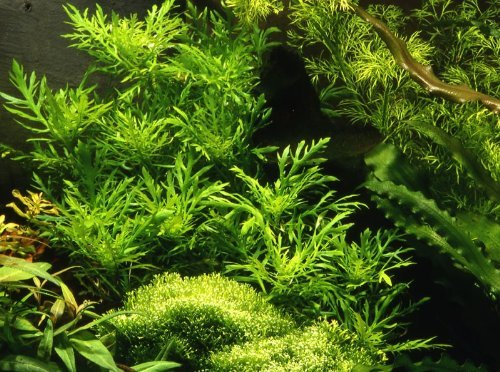Adding live or plastic aquarium plants to your fish tank is a great way to provide some decoration and sheltered hiding places for your fish.
The question is, which is best? Should you go with real or fake plants?
In this post, we are going to look at what you should consider when deciding between keeping live or plastic aquarium plants in your tank.
The Benefits of Live Plants
- Keeping live plants, such as hornwort, in a goldfish tank definitely has its perks. For one thing, they won’t look fake and will make your tank more closely resemble a real outdoor underwater environment. This is probably the most common reason goldfish keepers choose live plants for their aquariums.
- Live plants also help to oxygenate your aquarium water. As the animals in the tank produce carbon dioxide, the plants absorb it and release oxygen. The goldfish then uses the oxygen to breathe. While plants are not the only way to provide oxygen for your goldfish, they do help.
- Live plants also assist in the breaking down of organic waste and toxins. This provides a sort of “natural filtration” and can help to keep the water clear.
The Drawbacks of Live Plants
- One downside to live plants is their destructibility. Goldfish will munch on just about any plant, so finding a plant that will not be eaten can be tricky. Even if the goldfish cannot digest the plants, they will often tear them apart. This can lead to clogged filters and a messy tank.
- Live plants need regular pruning, as well as proper substrate for root growth. This means more work on your part.
- Some goldfish owners like to include live plants in their tank so that their fish can graze whenever they like. This helps to promote good digestion and growth.
- If they are not properly cleaned, Live plants can introduce harmful bacteria and diseases into your tank.
The Benefits of Plastic Aquarium Plants
- Plastic plants are virtually indestructible. Goldfish may peck on them to try to find food, but will never succeed in damaging them. This is especially nice when it comes to maintaining a clean aquarium.
- Plastic plants can last for years and always retain their shape and color. They can be easily arranged and rearranged in the substrate without fear of damaging delicate root systems and are often weighted for convenient positioning.
- Plastic aquarium plants are very low-maintenance. They don’t demand anything more than an occasional scrub to remove algae.
- There is a wide variety of plastic plant types and colors to choose from. Ranging from lifelike to whimsical, there is something for everyone’s taste.
The Drawbacks of Plastic Plants
- Plastic plants can never achieve the level of realism that live ones do. Some plastic plants do look very realistic, but nature’s detail can’t be mass produced.
- Obviously, plastic plants don’t help add oxygen to your water. You will have to rely solely on your filter, air pump and water changes to balance the parameters in your tank. Plastic plants are only useful to provide shelter for the fish and aesthetic improvement to the aquarium.
- Goldfish cannot snack on live plants throughout the day, and must be content to wait until mealtimes for food. Young goldfish fry also make use of the microscopic algae particles and nutrients of live plants when they are very small. This is not something plastic plants can afford to breeders, beside the spare bit of algae that may grow on the surface of the fake plant when exposed to light.
So, which type of plant should you choose? Real or plastic?
Our advice is to do what is best for your own situation. Experiment between live plants and plastic and find out which works best for you.
Ultimately, as a goldfish-keeper, you will have to decide which works best for you and your tank.
